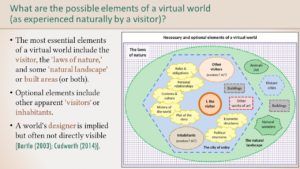Gladden, Matthew E. “A Phenomenological Analysis of the Virtual World as Aesthetic Object: Echo, Deepening, or Dissolution of the Lifeworld?” Presentation at the 17th Annual Conference of the Polish Phenomenological Association: History, Body, and Life-World – On Patočka and Beyond. Institute of Philosophy and Sociology, Polish Academy of Sciences, Warsaw. December 15, 2017.
 Abstract. In this work we build on the ontological and aesthetic frameworks formulated by Roman Ingarden to develop a phenomenological analysis of the virtual world as aesthetic object. First, ‘virtual reality technology’ is distinguished from ‘virtual environments’ and ‘virtual worlds.’ The types of immersive, interactive virtual worlds accessed through contemporary VR technologies are further distinguished from the types of ‘virtual worlds’ accessed, e.g., by reading a novel or watching a film. Essential and optional elements of virtual worlds are identified, with special attention given to the (software-enforced) ‘laws of nature’ governing the structure and dynamics of elements in a world, the pseudo-natural origins of apparently ‘natural’ elements like wild animals and geographic formations, and the unique positions of the world’s designer(s) and human visitor(s). The potential ‘incompleteness’ of virtual architectural structures and inability to determine whether one’s social interactions are with human or artificial agents is analyzed in light of Ingarden’s interpretation of Husserl’s phenomenological model of intentionality and the perception of objects. It is shown that a virtual building, e.g., does not display all the features of a real-world building but instead possesses some characteristics found in real-world paintings.
Abstract. In this work we build on the ontological and aesthetic frameworks formulated by Roman Ingarden to develop a phenomenological analysis of the virtual world as aesthetic object. First, ‘virtual reality technology’ is distinguished from ‘virtual environments’ and ‘virtual worlds.’ The types of immersive, interactive virtual worlds accessed through contemporary VR technologies are further distinguished from the types of ‘virtual worlds’ accessed, e.g., by reading a novel or watching a film. Essential and optional elements of virtual worlds are identified, with special attention given to the (software-enforced) ‘laws of nature’ governing the structure and dynamics of elements in a world, the pseudo-natural origins of apparently ‘natural’ elements like wild animals and geographic formations, and the unique positions of the world’s designer(s) and human visitor(s). The potential ‘incompleteness’ of virtual architectural structures and inability to determine whether one’s social interactions are with human or artificial agents is analyzed in light of Ingarden’s interpretation of Husserl’s phenomenological model of intentionality and the perception of objects. It is shown that a virtual building, e.g., does not display all the features of a real-world building but instead possesses some characteristics found in real-world paintings.
Drawing on Ingarden’s framework, the (physical) ontic basis of a virtual world is distinguished from the (purely intentional) virtual world as a work of art that is grasped through perception and the related aesthetic and cultural objects that may be constituted by a visitor who undergoes the right sort of conscious experience. The stratification of a virtual world as a work of art is also investigated. Building on Ingarden’s critique of Husserl’s concept of the ‘lifeworld’ as the natural world that is simultaneously (a) stripped of modern scientific theory and (b) the world that we live in and manipulate, it is suggested that VR-facilitated virtual worlds (like other highly technologized forms of art) undermine the factual possibility for such a lifeworld to exist. In response, though, Patočka’s notion (influenced by Ingarden) of fictional literary worlds as ‘echoes’ of the lifeworld is noted; we thus close by raising the question of whether certain virtual worlds might potentially be employed to help restore the possibility of (perhaps temporarily) establishing a Husserlian lifeworld.